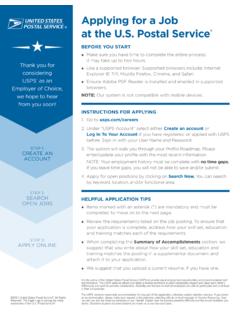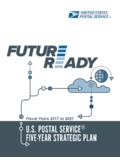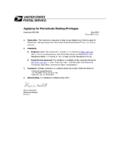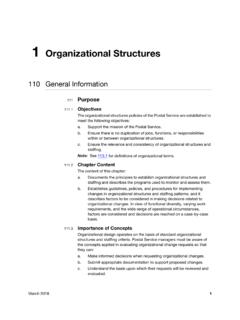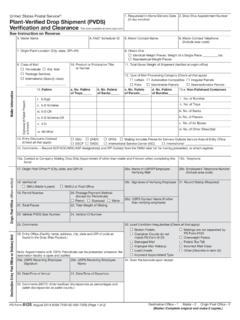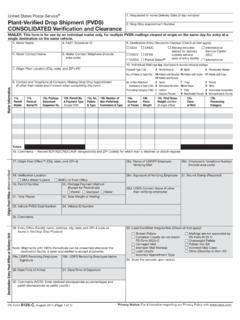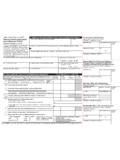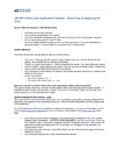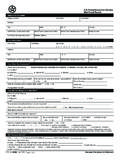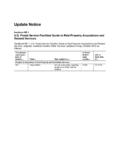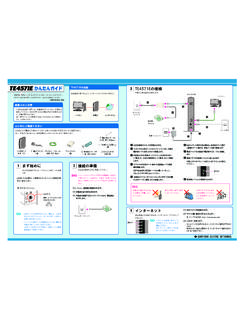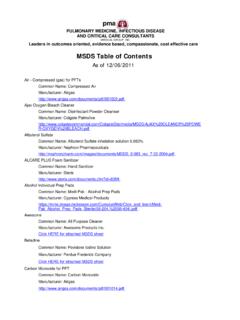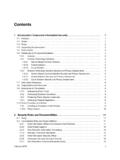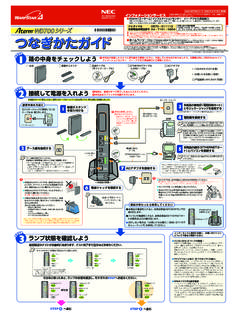Transcription of Handbook AS-805-C - Information Security …
1 Information Security requirements for All Personnel Handbook AS-805-C . October 2015. Availability Integrity Confidentiality Information Security requirements for All Personnel Handbook AS-805-C October 2015. Transmittal Letter A. Explanation: The appropriate use of the resources that the Postal Service . provides is important. It can affect the efficiency of our day-to-day business activities, the success of new business opportunities, and the preservation of the trust and Security represented by the Postal Service brand. This Handbook summarizes what you need to know about protecting Postal Service Information resources; the Information Security policies that govern their use; and the protection of sensitive, sensitive-enhanced (including personal identifiable Information and payment cardholder Information ), and critical Information . By understanding your role, responsibilities, and significance to protect this Information , you become a major contributor to a successful Information Security program.
2 Follow the instructions on the last page of this Handbook to complete the Acknowledgement of Information Security Awareness Training. B. Availability: This Handbook is available on the Postal Service intranet at C. Comments: Submit questions or comments about this Handbook to: CORPORATE Information Security OFFICE. UNITED STATES POSTAL SERVICE. 4200 WAKE FOREST RD. RALEIGH, NC 27668-1510. Comments may also be sent by e-mail to: Use AS-805-C , Information Security requirements for All Personnel as the subject header. D. Effective Date: This Handbook is effective immediately. Randy S. Miskanic (A) Chief Information Officer and Executive Vice President Information Security requirements for All Personnel Contents 1. Introduction .. 1. What This Handbook Covers.. 1. 2. Logon IDs, Passwords, PINs, and Tokens.. 1. Getting Access.. 1. Creating a Password .. 2. Using Logon IDs and Password.. 2. Using Screensaver Time-Out and Password.
3 3. Using PINs.. 4. Using Tokens.. 4. Resetting Passwords.. 4. 3. Use of Information Resources.. 4. E-mail Use.. 6. Internet Use.. 7. Remote Access and Telework.. 8. Domestic Travel.. 9. International Travel.. 9. Wireless Technologies.. 10. 4. Protection of Sensitive and Critical Information .. 11. Sensitive Information .. 11. Sensitive-Enhanced Information .. 11. Critical (Moderate) Information .. 16. Critical (High) Information .. 16. 5. Protection Against Viruses and Malicious Code .. 17. Worms, Trojan Horses, and Trap Doors.. 17. Preventing Infection.. 17. Responding to Infections.. 18. 6. Hardware and Software .. 18. Using and Adding Hardware and Software.. 18. 7. Information Security Incidents.. 19. Recognizing Incidents.. 19. Preventing Incidents.. 20. Responding to Incidents .. 20. 8. Monitoring of Information Resources.. 21. Why the Postal Service Monitors.. 21. How You Are Notified.. 21. We Are Interested in Hearing From You.
4 22. Acknowledgement of Information .. 22. Security Awareness Training .. 22. ii Handbook AS 805-C, October 2015. Information Security requirements for All Personnel 1. Introduction What This Handbook Covers HBK AS-805 This Handbook summarizes Information Security requirements Available at for all personnel, including designated personnel handling payment card Information . For a complete explanation of com/handbooks/ Information Security policies, please refer to HBK AS-805, Information Security . 2. Logon IDs, Passwords, PINs, and Tokens Getting Access Logon ID The Postal Service uses logon identifications (IDs), passwords, A unique identifier personal identification numbers (PINS), and tokens to manage assigned to a user access to its Information resources. when access is authorized. Temporary Need access to basic computer services? Information Services If you don't have access to computer services Active directory but need it to do your job, ask your supervisor account, e-mail, or manager.
5 Information Technology will notify office suite of you when you have been granted access to services, and computer services. intranet browser access. eAccess Need additional access? Online computer request If you already have access to basic computer application at services but need to add services, then you or https://eaccess. your manager can request it using eAccess. Handbook AS 805-C, October 2015 1. Information Security requirements for All Personnel Creating a Password What to do when you create a password . Password Use alphanumeric passwords with at least fifteen (15). A string of characters. characters you Choose a password that is hard for others to guess, such know' that can be used for as phrases or word strings. authentication, , Use at least one character from three of the four following provides proof that types of characters: you are who you say you are when using a -- Upper case letters (A Z).
6 Given logon ID. -- Lower case letters (a z). -- Numerals (0 9). -- Non-alphanumeric characters (special characters such as &, #, and $). Change your password every 90 days. See Handbook AS-805 if you are a privileged user or work in Information Technology. What not to do when you create a password . Do not use all the same characters or digits or other commonly used or easily guessed formats. Do not use your name, family members' names, birth date, or other personal Information . Do not use terms such as Post Office or user or other Postal Service terminology or acronyms. Do not use words that appear in the dictionary. Do not use your logon ID. Do not repeat your passwords. Using Logon IDs and Password What to do when using logon IDs and passwords . Keep your password confidential. You are accountable for the actions of anyone using your logon ID and password, even if you didn't give the user permission.
7 Change your password if you think it has been compromised and notify the Computer Incident Response Team (CIRT) using the procedure described in section 7, Information Security Incidents, of this Handbook . 2 Handbook AS 805-C, October 2015. Information Security requirements for All Personnel If you have forgotten your password or your account has been disabled because you made six unsuccessful attempts to enter your account, use ePassword Reset to re-set your password. The ePassword Reset program will automatically re-set the password to a temporary password, which you must change the next time you log on to the network. If you write your personal password down, store it under your personal control or in tamper-resistant manner ( , an envelope with a registry seal, time stamped, and signed) to ensure that any disclosure or removal of the written password is clearly recognizable. What not to do when using logon IDs and passwords.
8 Do not write your personal password on a sticky and attach it to your monitor. Don't share your personal password under any circumstances, including in the following examples: -- Don't share your personal password with IT technical support staff working to resolve a Service Desk or system upgrade ticket related to your system. -- Don't share your personal password with coworkers to enable them to access your system for any reason ( , to resolve any issues related to teleworking and to enable them to access a file, application, e-mail message, attachment, or meeting/calendar-related Information .). -- Don't share your personal password with a family member or personal acquaintance to enable them to access the Internet or use MS Office or other USPS . applications installed on a USPS computing device. Never let anyone use your logon ID or password and do not use anyone else's. Do not store your password in application code, files, or tables.
9 Do not transmit a password for access to your system, to an encrypted document, or to an archive in clear text in an e-mail. Screensaver Protects Information Using Screensaver Time-Out and when you are away from the computer Password but not logged out. Make sure your screensaver time-out feature is working;. and if not, contact the IT Service Desk. Handbook AS 805-C, October 2015 3. Information Security requirements for All Personnel PIN. A specialized Using PINs authenticator for Protect PINs with the same care as you protect passwords. limited applications and usually used with a token. Using Tokens Protect your token from theft. Token Do not allow anyone else to use it. A small tangible object that Do not leave tokens out in plain sight when not in use;. contains a built-in secure them in locked drawers. microprocessor used Tokens are required for remote access to payment to store and process cardholder Information .
10 Information for authentication. Resetting Passwords If you suspect your password has been compromised, change it immediately by using the Change Password function button on the Window Security Web page (available by simultaneously depressing the Ctrl, Alt, and Delete keys) and notify CIRT using the procedures described in section 7, Information Security Incidents, of this Handbook . If you forget your password, use ePassword Reset (available from the Postal Service Intranet, , and from the following links) to reset it: -- Application Password (https://epasswordreset). -- Mainframe Password (https://epasswordreset). 3. Use of Information Resources General Use What to do when using Information resources . Limited Personal Use Follow Postal Service limited personal use policies. See Protect our workstations, laptop computers, and handheld MI EL-660-2009-10, Limited Personal Use devices, both on and off Postal Service premises, against of Government theft and misuse by following all Postal Service Information Office Equipment Security requirements .
